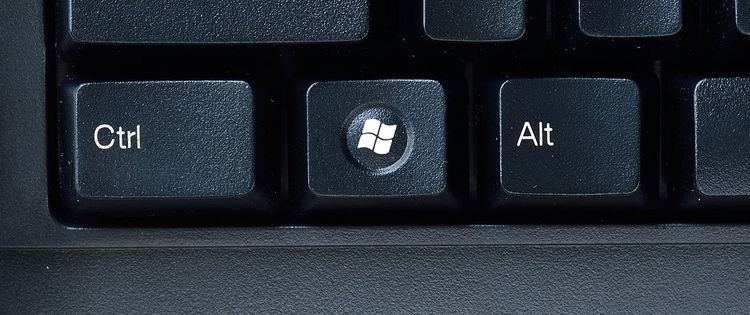 | ||
The Windows logo key (also known as Windows key, start key, logo key, flag key, super key, command key, flag or home) is a keyboard key which was originally introduced on the Microsoft Natural keyboard in 1994. This key became a standard key on PC keyboards. Tapping this key invokes the operating system's start menu, if it has one. In Windows, Ctrl+Esc performs the same function, in case the keyboard lacks this key.
Contents
- Licensing
- Use with Microsoft Windows
- Windows 95 and Windows NT 40
- Windows XP
- Windows XP Media Center Edition
- Windows Vista
- Windows 7
- Windows 8
- Windows 81
- Windows 10
- Microsoft Office
- Use with non Microsoft operating systems
- References
Historically, the addition of two Windows keys and a menu key marked the change from the 101/102-key to 104/105-key layout for PC keyboards: compared to the former layout, a Windows key was placed between the left Ctrl and the left Alt; another Windows key and—immediately to its right—a menu key were placed between the AltGr (or right Alt key on keyboards that lack AltGr) and the right control key. In laptop and other compact keyboards it is common to have just one Windows key (usually on the left). Also, on Microsoft's Entertainment Desktop sets (designed for Windows Vista), the Windows key is in the middle of the keyboard, below all other keys (where the user's thumbs rest).
On Windows 8 tablet computers, hardware certification requirements initially mandated that the Windows key be centered on the bezel below the screen, except on a convertible laptop, where the button is allowed to be off-center in a tablet configuration. This requirement was relaxed in Windows 8.1, allowing the Windows key to be placed on any bezel or edge of the unit, though a centered location along the bottom bezel is still preferred.
Licensing
Microsoft regulates the appearance of the Windows key logo picture with a specially crafted license for keyboard manufacturers ("Microsoft Windows Logo Key Logo License Agreement for Keyboard Manufacturers"). With the introduction of a new Microsoft Windows logo, first used with Windows XP, the agreement was updated to require that the new design be adopted for all keyboards manufactured after 1 September 2003. However, with the release of Windows Vista, Microsoft published guidelines for a new Windows Logo key that incorporates the Windows logo recessed in a chamfered lowered circle with a contrast ratio of at least 3:1 with respect to background that the key is applied to.
In Common Building Block Keyboard Specification, all CBB compliant keyboards were to comply with the Windows Vista Hardware Start Button specification beginning in 2007-06-01.
Use with Microsoft Windows
On Windows 9x and Windows NT families of Windows operating system, tapping the Windows key by itself traditionally revealed Windows Taskbar (if not visible) and opened the Start menu. In Windows Server 2012 and Windows 8, this key launches the Start menu but doesn't show the taskbar. However, this feature was added back into Windows 10.
Pressing the key in combination with other keys allows invoking many common functions through the keyboard. Holding down Ctrl+Esc will not substitute for the Windows key in these combinations. Which Windows key combinations ("shortcuts") are available and active in a given Windows session depends on many factors, such as accessibility options, the type of the session (regular or Terminal Services), the Windows version, the presence of specific software such as IntelliType and Group Policy if applicable.
Below is a list of notable shortcuts. Unless otherwise noted, they are valid in the next version of Windows.
Windows 95 and Windows NT 4.0
The following shortcuts are valid in Windows 95 and Windows NT 4.0.
Windows XP
Windows XP adds the following shortcuts.
Windows XP Media Center Edition
Windows XP Media Center Edition adds the following:
Windows Vista
Windows Vista adds the following shortcuts:
Windows 7
Windows 7 introduces the following:
Windows 8
Windows 8 introduces the following:
Windows 8.1
Windows 8.1 introduces the following:
Windows 10
Windows 10 introduces the following:
Microsoft Office
Additional installed software may introduce other shortcuts using the Windows key. For example, various Microsoft Office applications add shortcuts of their own:
Use with non-Microsoft operating systems
The Windows key can also be used on other operating systems.
On Unix and Unix-like operating systems, it is sometimes called "Meta" or "Super". The X window system usually treats this key as modifier MOD4. KDE and GNOME, which are commonly the default desktop environments of Linux distributions, usually support the key, though it may be necessary to configure its functionality after installation. GNOME Shell uses the Super key as its default keyboard shortcut for bringing up the Activities Overview. Similarly, Cinnamon uses the Super key to pop-up its main system menu (normally docked at lower-left of screen). In the Compiz window manager, the Super key can by default be used in conjunction with the scroll wheel to zoom in or out of any part of the desktop. OS X uses the Windows key as a replacement for the Command key if the keyboard does not include the latter. This sometimes leads to placement issues for users used to Apple keyboards however, as the Command key is usually placed where the Alt key is on most keyboards (next to the Space bar).
On Xbox 360, pressing the Windows key performs the same action as the Guide button on Xbox 360 Controller or remote controls, opening the Xbox Guide. Holding down the Windows key and pressing M opens a pop up conversation window over gameplay, if an instant message conversation is in progress. On a PlayStation 3 console, pressing the Windows key performs the same action as the PS Button on the Sixaxis Controller, opening the XrossMediaBar.
